When we land in Mendoza all memory of flash flooding and a leaky hotel is erased instantly with one glance at the Andes Mountain range. The mystical mountains greet us outside the Mendoza airport and seem to carry a quiet and calming presence. It’s like we are getting a fresh start with the fresh mountain air. Our guide, Leticia, introduces Mendoza to us as the land of sun and wine and we are ready for both. She also explains that what we’ve just seen are the pre-Andes. I can’t wait to see what the full mountain range looks like. On the way into Mendoza city, we get a bit more background on this naturally dry and mountainous desert region where it only rains a few times a year and is somehow amazingly fertile at the same time. Mendoza is not only known for its wines, Malbec, in particular, but also olives, apples, pears, plums and apricots, all because of an irrigation system built by its indigenous inhabitants and built upon by its more recent European residents who added dams to redirect water to dry areas as needed.
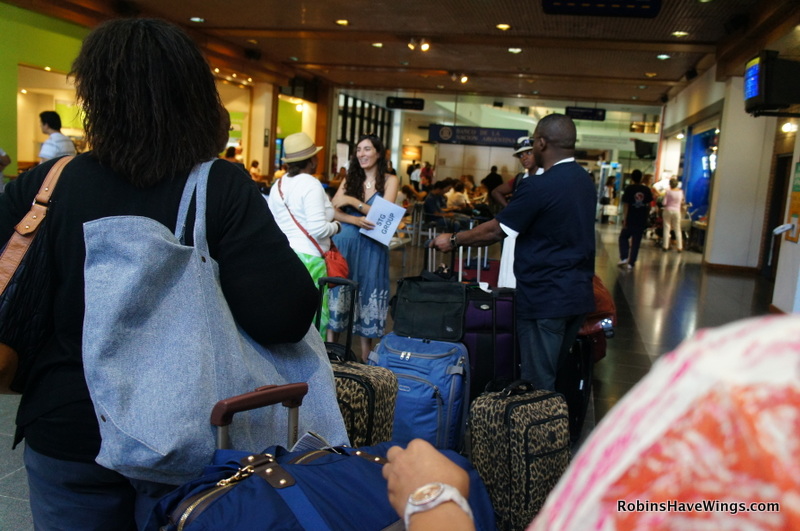
We see the system of narrow cobbled ditches as we wander around Mendoza City, which is the antithesis of Buenos Aires. You want to go slow here. Strolling is definitely in order in Independence Plaza, its main square which is surrounded by park benches and centered by a beautiful bursting fountain. We find a few vendors here on a Monday afternoon and wonder what this place would be like on a weekend. Gai and Carmen are drawn to belts made by one mate drinking vendor. Mate is Argentina’s green tea, made popular by the gauchos. Kenitra and I study handcrafted jewelry with local stones by a local woman. Beyond the square is a wide promenade of shops and restaurants. Kenitra and I take Chile street to see if we can start our wine tasting immediately, but when we reach the lovely shop simply called The Winery which looks more like an art gallery with wines and wine accessories artfully displayed in rooms under chandeliers, we learn that they aren’t doing tastings at the moment. By this time we’re hungry, but we don’t have much time and bemoan the fact that there doesn’t appear to be quick street food in Argentina. I guess it is because of its European roots in Spain where you take your time with food whether eating or serving it. We duck into a neighborhood bakery hoping to snag a quick empanada and end up standing around in the hot narrow shop for about 30 minutes or more along with a few local patrons who seemed like they wanted their food fast, too. But I guess that was fast by Argentinian standards. It was a good empanada. Juicy as it should be.
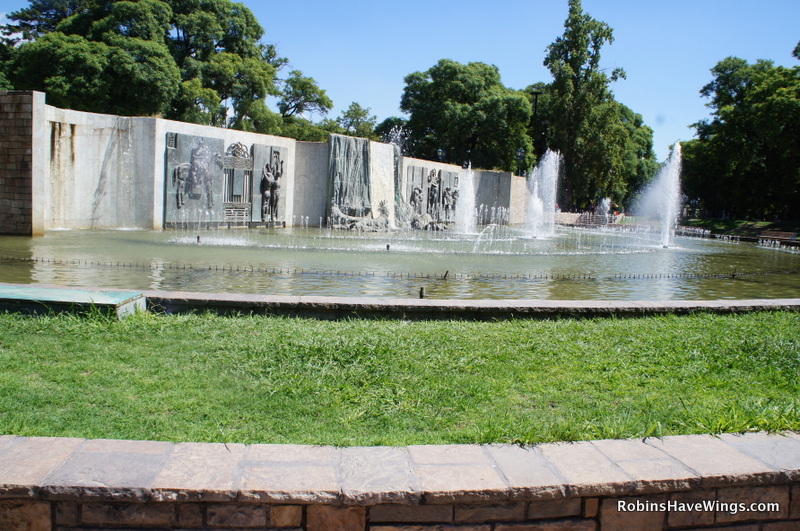
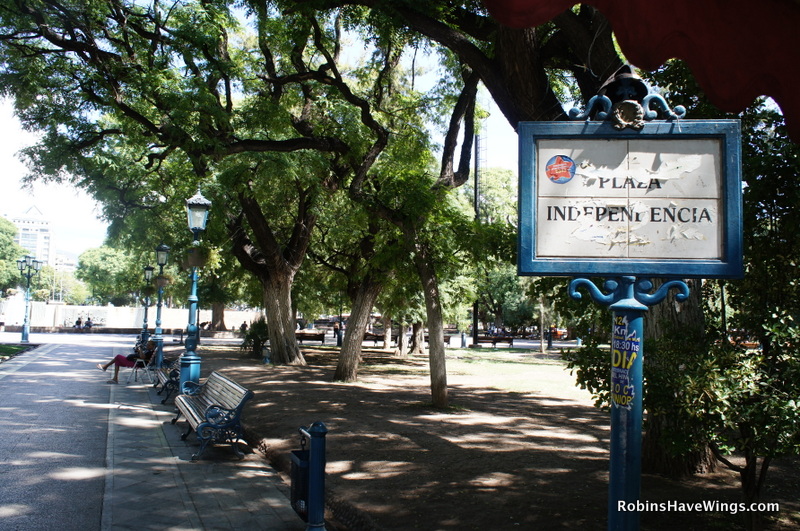
If just getting a glimpse of the Andes was enough to make us forget the unfortunate flooding in Buenos Aires, Finca Adalgisa makes it seem as if it never happened. Walking through the gates of the property feels like we’ve awoken from a bad dream and everything is right with the world, especially one where you live in an 80-year-old vineyard with a gorgeous pool surrounded by lush grounds. We are greeted warmly by the hotel manager, Theresa, who gathers us for a tour of our new home explaining its history as the winery of the Furlotti family, run to this day by its grand-daughter Gabby. The library features sepia photos of its familial founders along with worn leather seats and books for the taking to read there or in a hammock outside your room. We perk up when we learn that there is a happy hour every evening at 6 pm where there are free tastings of Adalgisa wine in their wine bar and lounge. We decide to pass the time until happy hour lounging by the pool nestled amongst rows and rows of grape vines.
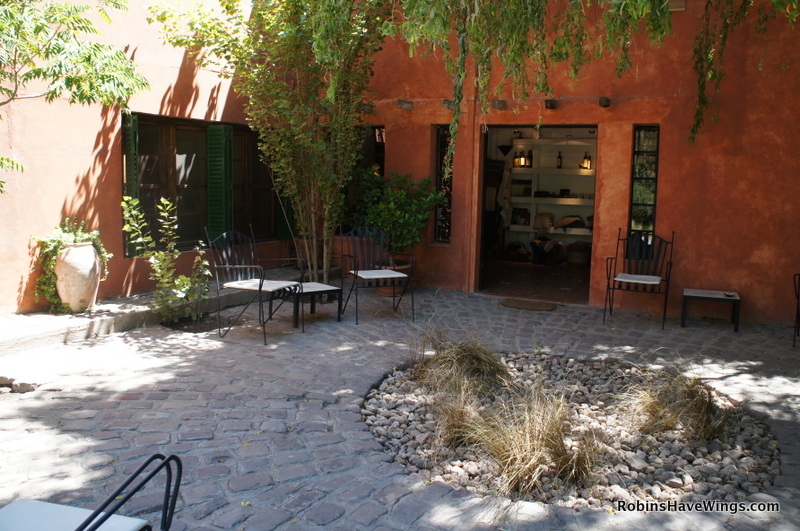
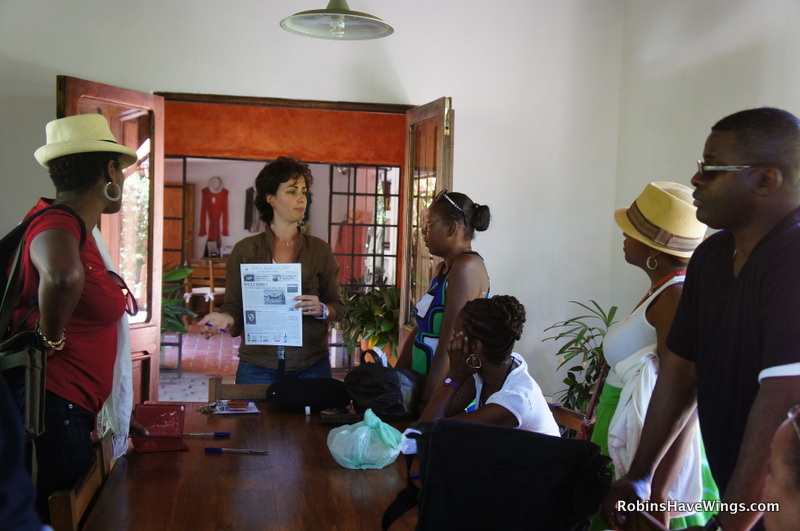
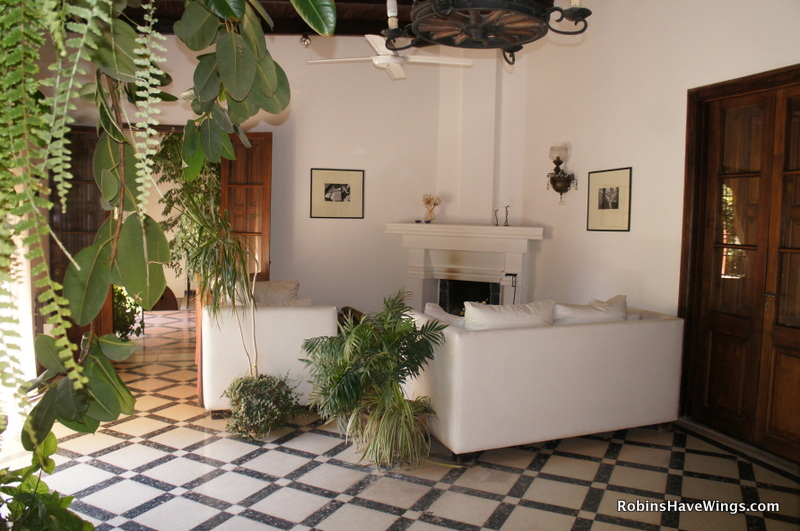

It’s the ultimate in relaxation and we think it can’t get any better until we actually go to the happy hour, which looks to be in a simple white stone building from the outside, but the interior looks like we’ve stepped into the pages of Architectural Digest. A tree grows from the center of the room through the ceiling and plush white couches surround it with a 180 degree of the vineyards beyond. It’s stunning and cozy at the same time. The patio offers an unobstructed view of the sun setting over the vineyards and then the wine arrives. We are drinking a 2008 Malbec from our new home and it’s delicious as are the olives, cheeses and breads served. With the arrival of the wine comes a new level of relaxation and our group bond deepens. At first it’s just the ladies and we drift into conversation about relationships, not just with men but with each other. We learn more about each others histories and uncover our common interests beyond travel. When the the men join we are all laughing, recounting great moments so far on the trip as if we had always been the best of friends. Gai says this is her favorite part of her trips. She knows the bond will happen at some point and for us it was over wine in the middle of a Mendoza vineyard.

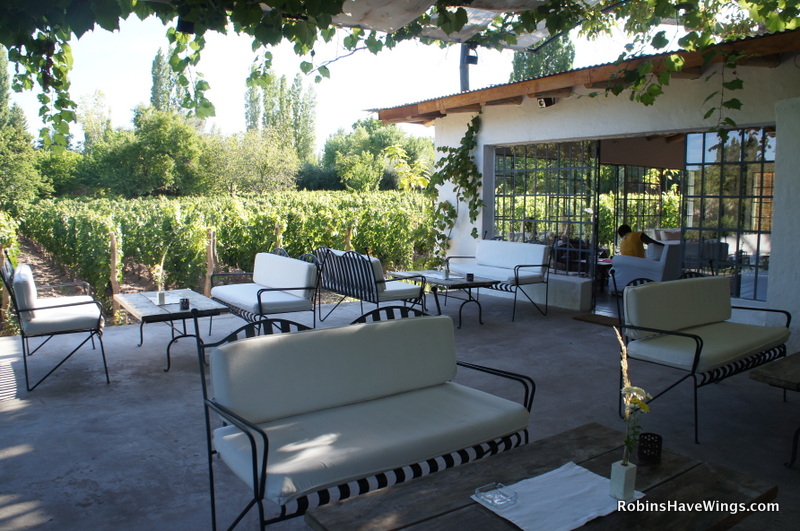
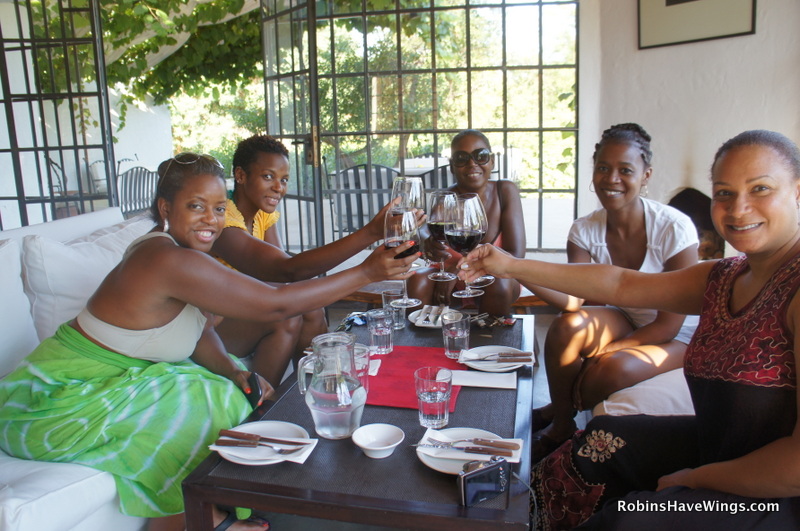
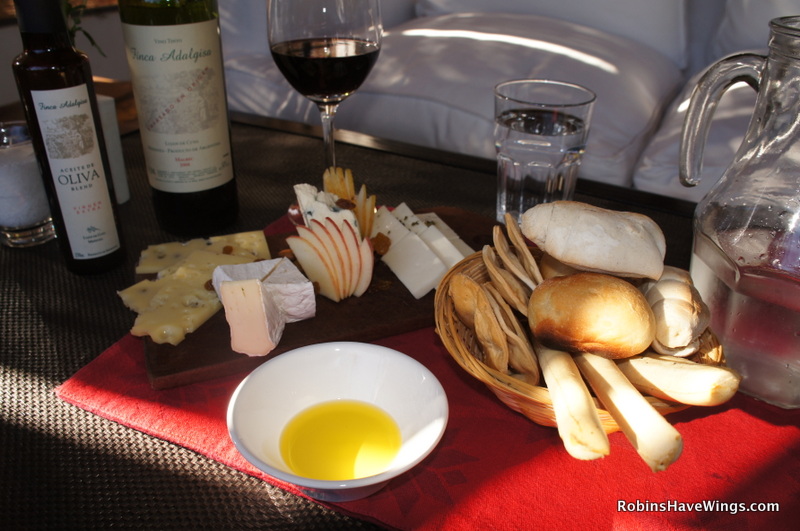
The wine continues to flow and the bonds continue to deepen the next day as we head out for our wine tasting tour an hour outside Mendoza proper in Tupungato which also shares the name of a long dormant volcano in the Andes. In fact, it is the third highest mountain in the Andes. Speaking of which, the Andes are following us on our drive or maybe we are following them. They first appear on the right and Leticia tells us that we’ve left the pre-Andes behind. Then they rise before us on the way into the Uco Valley known for Argentina’s finest wines, grown at about 900 meters above sea level, the highest altitudes in country. At times the mountain range is bright and sparkly and at others distant, under a heavy haze. Either way we can’t take our eyes off the approaching peaks and valleys, one of which is Aconcagua, the tallest mountain in the Americas. We struggle to capture them through the window of our van with our cameras zoomed as tightly as they will go.
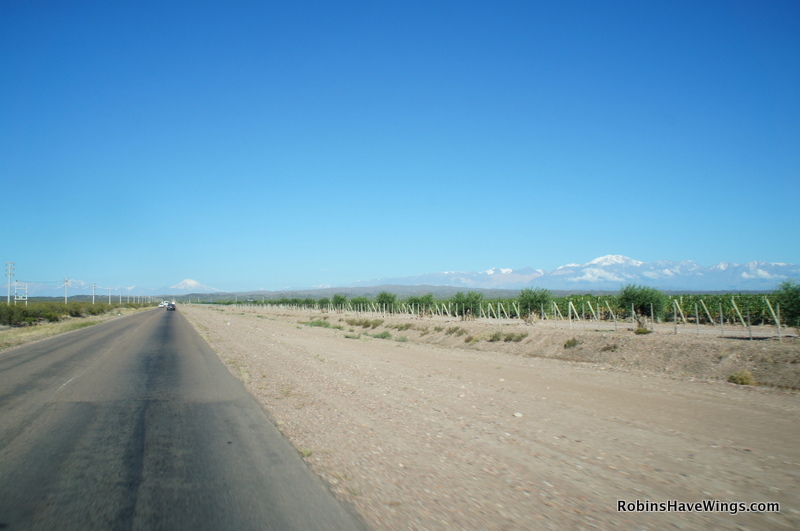
We ride over the parched Mendoza River, sucked dry of all its water, which has been rerouted to the city for drinking water, bathing and watering its crops. We also pass Route 7 which was to take us to the Chilean border the next day but an avalanche blocked part of the road leaving a long queue of cargo trucks to wait for the only road into Chile to open. We’ll have to make another plan.
The terrain continues to get more rocky, blanketed in a low-lying brush. Leticia tells us that not much else can grow in a place this dry. Every few miles, a patch of red flags stand at attention in the low dry grass or a small alter surrounded by water bottles appears. Gia is the first to notice them and ask about their meaning. The red flags are planted for Argentina’s Robin Hood, a man named Gauchito Gil, Leticia explains. He dressed in red and stole cattle from rich ranchers, sharing his booty with the poor. He was eventually caught, but he told his executioner that if he were buried, the man’s son, who was gravely ill would survive. The executioner buried Gauchito and the man’s son miraculously recovered. From then on people have sought good luck and blessings from Gauchito, especially truck drivers hoping for a safe journey. The other roadside saint is Difunta Correa, a mother who wandered the desert looking for her husband forced to fight in the civil war. Sadly, she died of thirst before she could find him and her child survived by suckling at her breast. So, today people leave bottles of water for the fallen woman. After passing these unofficial monuments, we spot a real one on a hill, Argentina’s Christ the Redeemer in the same arms-outstretched pose as the one in Brazil. This one looks towards the Andes and maintains peace between Argentina and Chile.
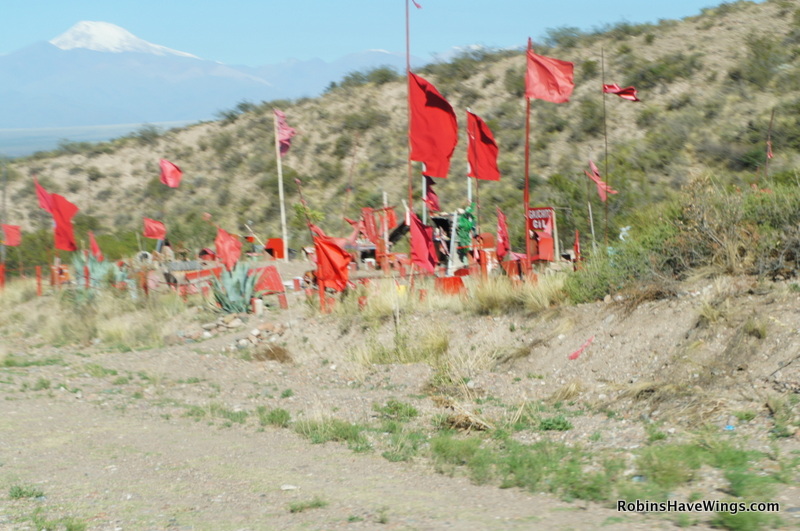
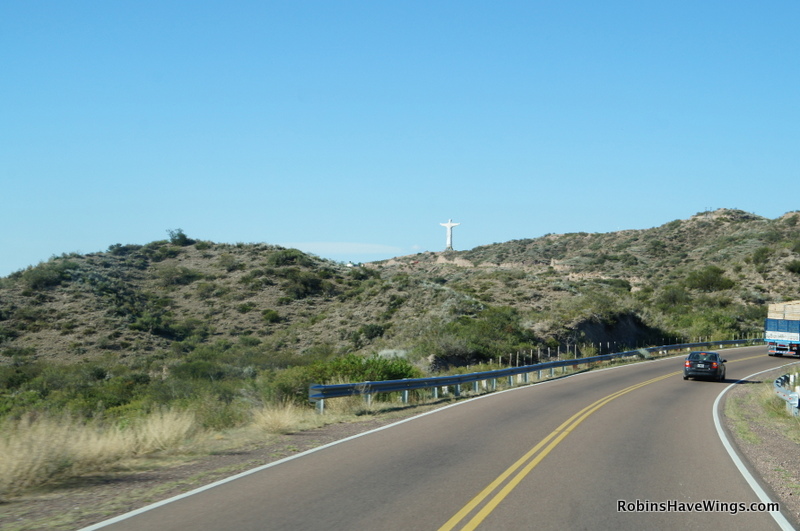
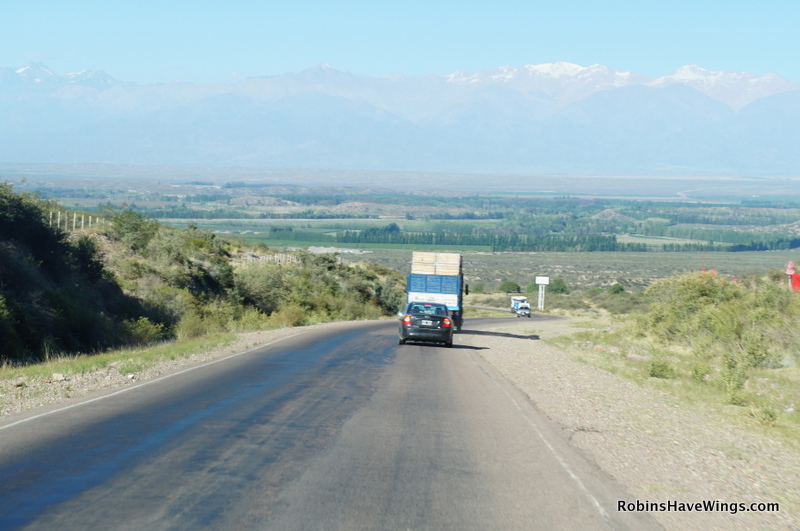
Just past the Christ statue, the Uco Valley unfolds before us like a verdant throw rug. It’s truly an oasis after the rough stretch of land we’ve just seen. It isn’t long before we pull up in front of Bodega Saletein. Could this really be a winery? It looks like a modern art museum rivaling MOMA with sculptures posed in the shadow of the Andes. Alan says they look close enough to touch. We are all wowed by the surroundings. Everyone has words like amazing, stunning and gorgeous to describe what they are seeing, but these words really don’t do it justice. This really is one of those times where you just have to be there. Rows and rows of vines seem to mark a series of straight paths to the mountains. Our vineyard tour guide takes us right up to the vines and asks us to pick a grape and taste one. We are stunned. Gia incredulously says, “You want us to pick them?” The guide is steadfast, so we head to the vines on the right to taste the Pinot Noir grapes. They are small, sweet and tart with a crunchy seed. Then she tells us to taste the grapes at the left. These have tougher skin and seem more bitter. Those grapes make Merlot. A few of us have been to wineries before and we were always told never to touch the grapes. But here at Saletein, our guide tells us that these grapes are grown just for the tasting.

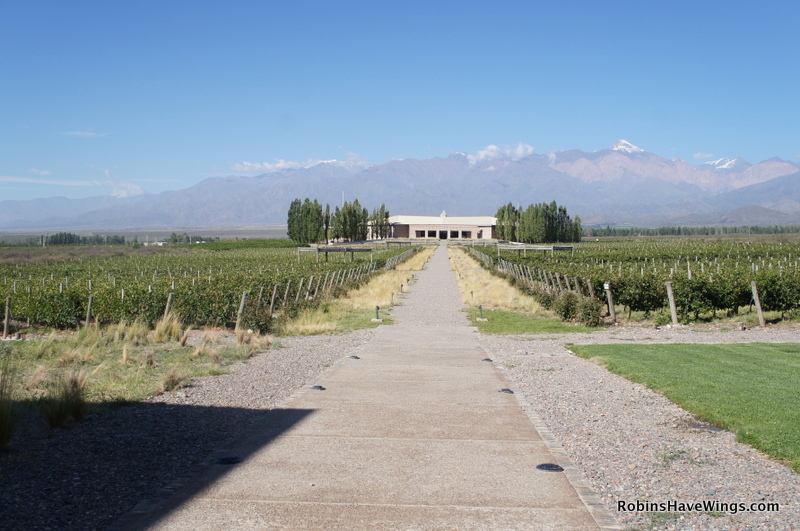
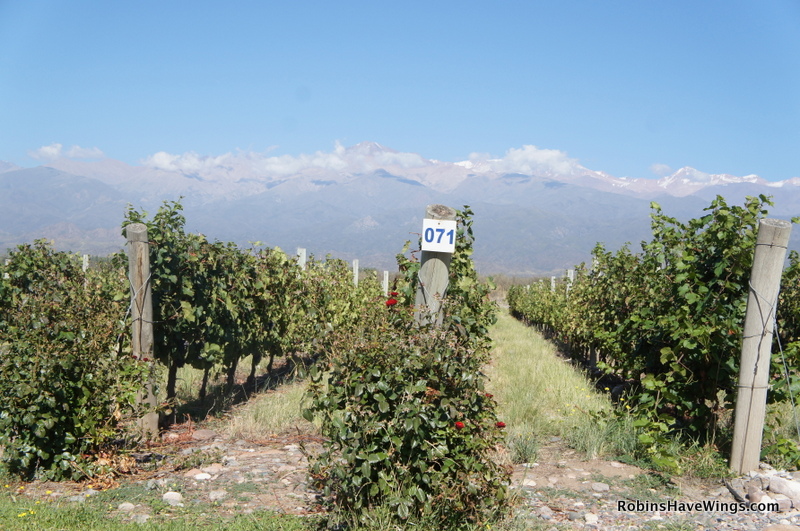
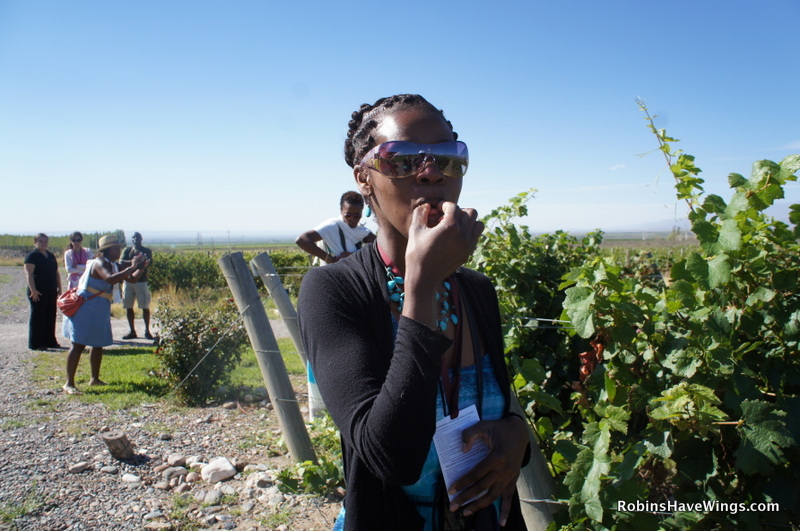
That’s not the only thing that impresses us at one of Argentina’s 10 largest wineries with possibly the best backdrop in the world. Deep in the recesses of this almost monumental building are steel vats in the most pristine of settings fermenting what we hope to be delicious wines. Our guide leads us to a circular railing in the center of this fermentation room and directs us to look down. French oak barrel upon French oak barrel sit respectfully in a circular theater surrounding a solitary grand piano as if waiting for a concert to begin. The room actually doubles as a cellar for its Primus wines, the winery’s most select label, as well as a concert hall, used for classical music concerts and tango performances once or twice a year. Depending on who you ask, the vibration from the music may actually add to these wines’ flavor, our guide explains. Once in the room, Gai, Carmen and Presleith decide to serenade the oak casks with “America the Beautiful” to test the room’s enveloping acoustics and spread some of our group flavor into the listening barrels.
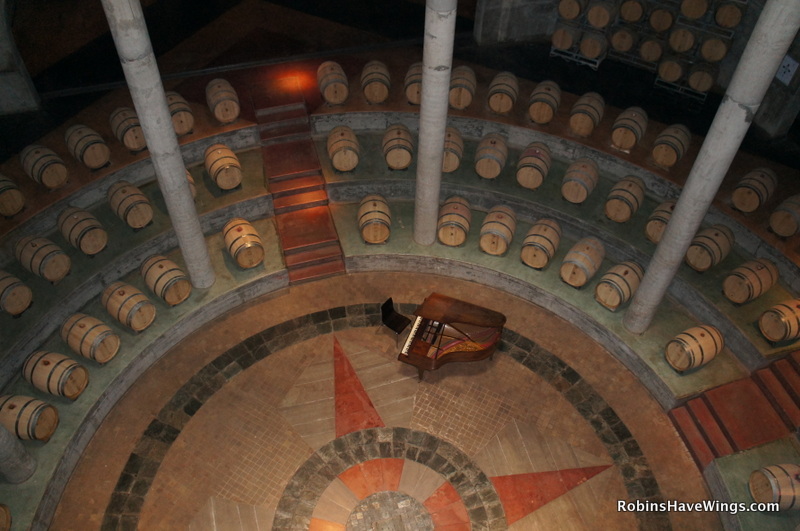
There were so many breathtaking details of this winery, including an eye-catching metal winding staircase and a tasting room built around a massive solid stone table. But it’s the wines that we’ve come here to taste and they don’t disappoint either. We start with a 2012 Sauvignon Blanc, a light, citrusy white liked by all, even Carmen who doesn’t drink at all. We end with another popular wine, the 2007 Malbec. It was a tad dry for my taste. I’m a fan of fruit-forward Zinfandels. But I get a bottle for my father who loves dryer reds and the rest of my travel compatriots proceed to almost clean out the winery’s shop before we head to our next destination.
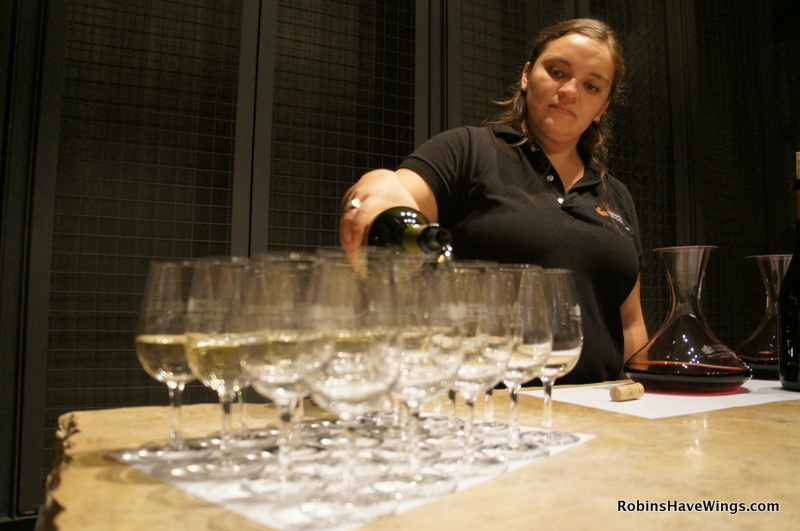
Somewhere down a very long and very, very bumpy gravel road, we find ourselves in a small mountain village called Gualtallary, named for a native chef that once ruled there. We turn into a small dirt driveway beyond a green wall to see a modest, salmon-colored stucco home with green trim. It seems to be the only house for miles on a well-farmed piece of land backed by a row of slim poplar trees and the Andes mountains. This is where we will be learning to cook just as the people who live here and the people who came before them. We immediately meet Michaela who has a quick and easy smile and runs La Tupiña Bistro, the family home turned restaurant of chef Lucas Bustos, who greets us as well. He’s in his chef’s coat just as a chef trained in French cuisine would be, but I notice that he is also wearing bombachas and alpargatas, the pants and shoes of a gaucho. A clue to his Argentinian background and formal training and a clue to the kind of cooking we’ll be doing. After having a glass of wine and meeting the staff under a shaded wooden canopy, we start to realize that we really will be getting our hands dirty. Gai says, “Oh, we aren’t play cooking, we’re really going to be cooking!” Some who have done other cooking classes may have imagined a class where you may chop a few things or toss some ingredients into a bowl while the chef does the real cooking, but that’s not what happens here. Lucas explains that every ingredient we will be using is local and grown on the farm and that we will be cooking like the locals do, everyday, with a wood fire on an open pit of hot coals.
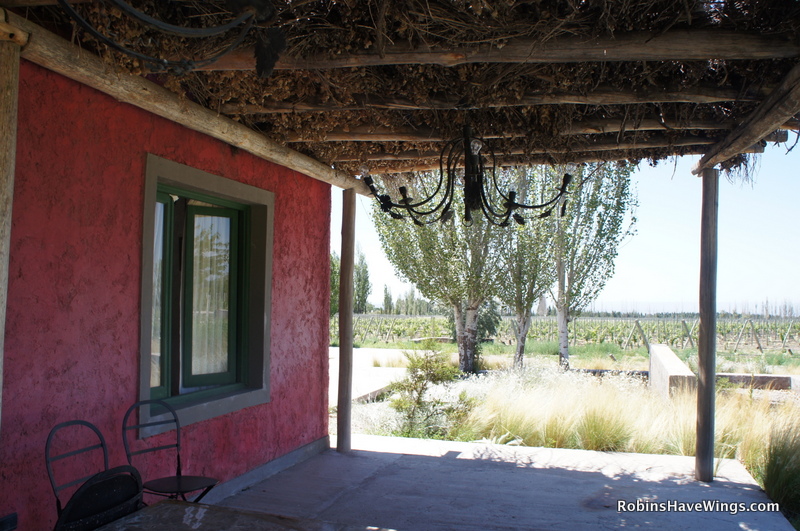
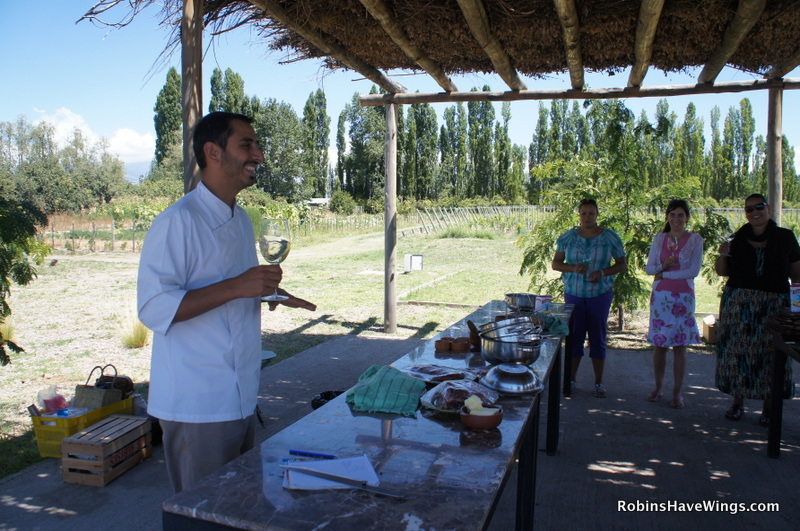
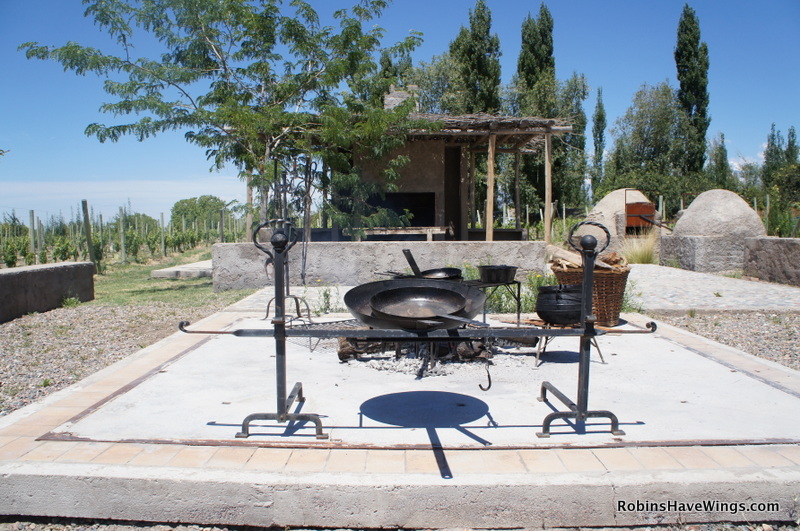
Everyone has kind of an excited “let’s do this” attitude and can’t wait to get to work. Lucas divides us into teams, some of us will work along side him and some will work alongside Michaela. We are all working on the tapas that we will have before the meal. I’m on Lucas’ team and he takes us out onto the farm to select the produce for the meal. He explains the process of keeping the soil shared by the Altus vineyard fertile; how to tell if a piece of corn is ready for picking and introduces us to squash blossoms. You can tell he is at home here in these fields, but he’s also at home feeding world leaders like Hillary Clinton. We learn that Lucas spent some time in Washington and cooked for the Clinton’s and an organization that former President Bill Clinton chaired before Hillary became Secretary of State. He raves about the Inn at Little Washington in the Washington area, which I have yet to visit and ask him if he’s been to Volt, one of my favorite restaurants. He hasn’t but says he’ll check it out the next time he’s in D.C.
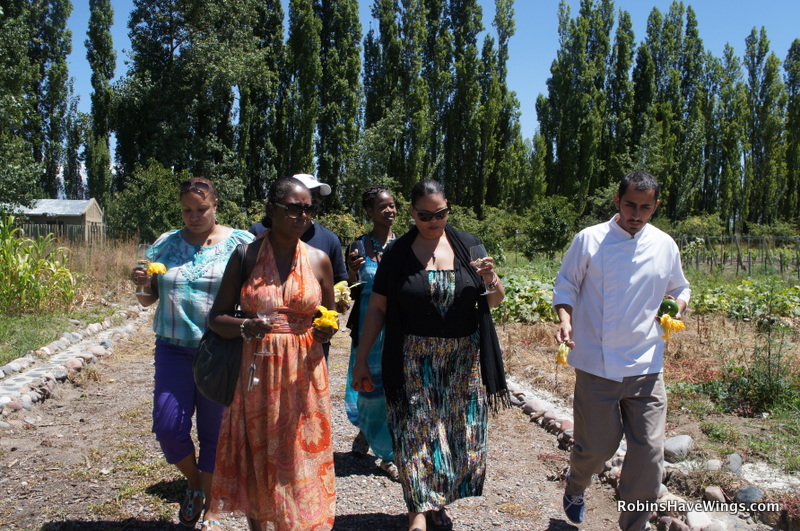
Armed with our produce, yellow and white corn, tomatoes, pumpkin and squash blossoms we return to our rustic cooking area, where Team Michaela is chopping more vegetables (carrots, zucchini, squash, peppers and onions) and putting them into a large cast iron skillet that will be placed on the fire to cook simply with salt and olive oil. Floyd chops the onions and minces meat for our empanada filling. Carmen and I chop red peppers, green onions and tomatoes for a salsa. Gia and I stuff squash blossoms with a local cheese to be dredged in a batter made with egg, flour, salt and oregano. We join Lucas near the fire and we watch him coat the blossoms and put them in a skillet of hot oil to cook until golden brown. During this process we learn more about Lucas, who tells us that after he finished training and cooking all over the world, he came back to Argentina to open a French restaurant in Buenos Aires. But he soon learned that no one was interested in French cuisine. Not the Argentinians and not the tourists who want to eat Argentinian cuisine when they arrive. So, he came to the Mendoza region where he is from to reconnect with Argentinian cooking.
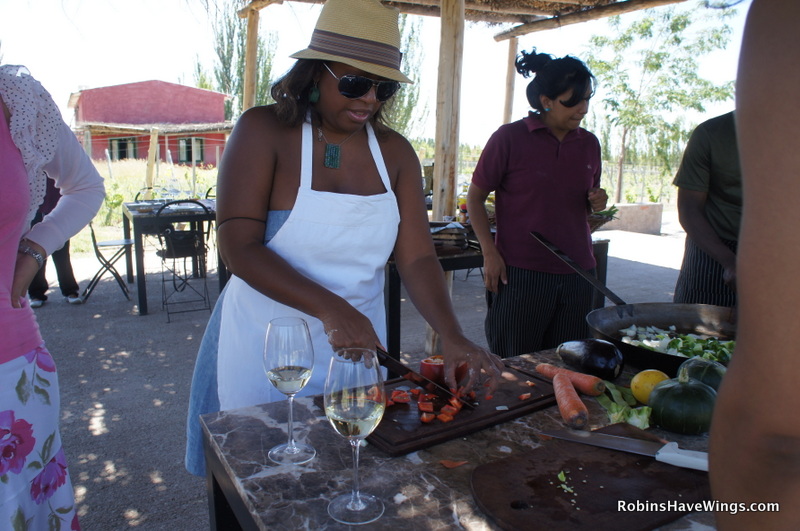
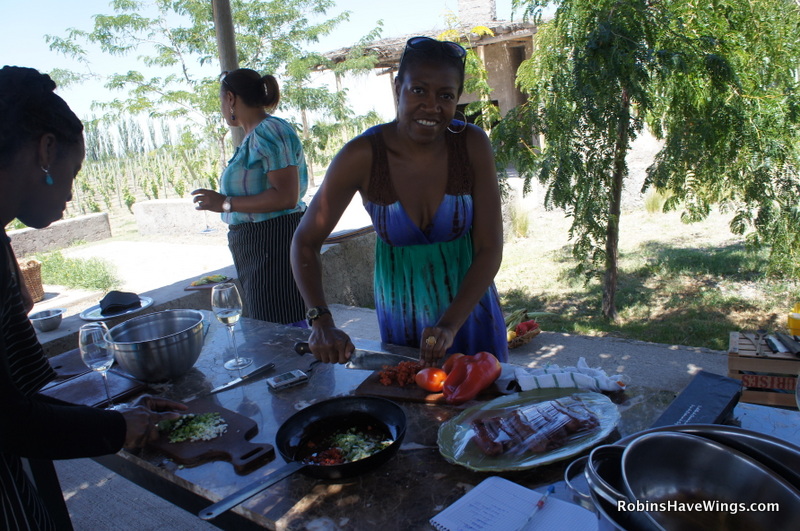
We are glad he did because those squash blossoms were delicious as was an egg scramble placed neatly back into its cracked shell for serving. Then there was the chorizo served on a flavorful twisted bread made by Team Michaela, topped with the salsa made by Team Lucas. Gai, Gia and I swoon over the taste. Gia has already declared her love for Lucas, even though he is married. And, then there were the empanadas, which Lucas shows us how to eat by folding a napkin around the bottom to keep the juicy contents from spilling out onto your clothes. Team Lucas, or rather Floyd stirred and stirred the meat, onion and lard filling until dry and Team Michaela used the mixture to stuff round flour dough shapes to make the tasty treats. The lard melts all the ingredients together while cooking to make the empanadas juicy. It’s cool to know the secret to the original hot pockets, but we are mostly proud of what we made and how good it tastes.

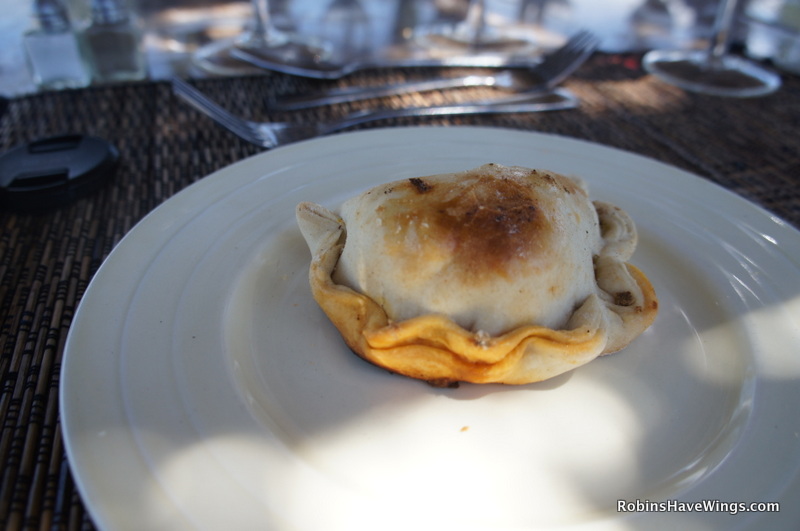
We don’t stop at the empanadas there is a full meal coming, including a hefty piece of beef known as “vacio.” It translates as empty, but it is definitely not that. It falls apart like stewed beef even though I’ve seen Lucas simply salt the cut of meat and lay it on a grill over a bed of coals to slow cook for about an hour. Carmen says that Lucas explained that this cut of meat can be found around the cow’s abdomen. Where ever it came from it was good and sitting on a bed of sautéed vegetables stirred and stirred by Alan who seemed not to mind the heat emanating from the nearby coals. Finally, there is desert, a small cup of a creamy dulce de leche, a kind of caramel-tasting confection loved by Argentinians, mixed with almonds, along with a slice of baked pear, piece of cheese and queen’s jelly. A queen is a fruit from the region that looks like an apple on the tree, but is inedible and must be cooked, typically into a jelly or spread.
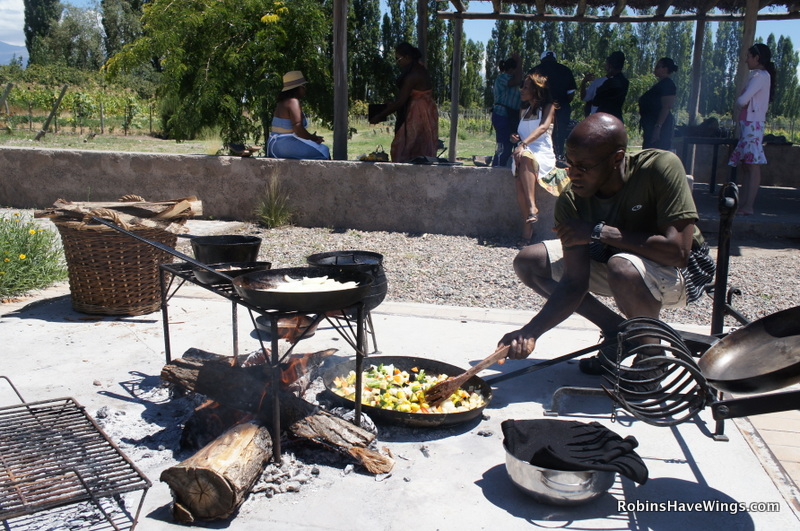
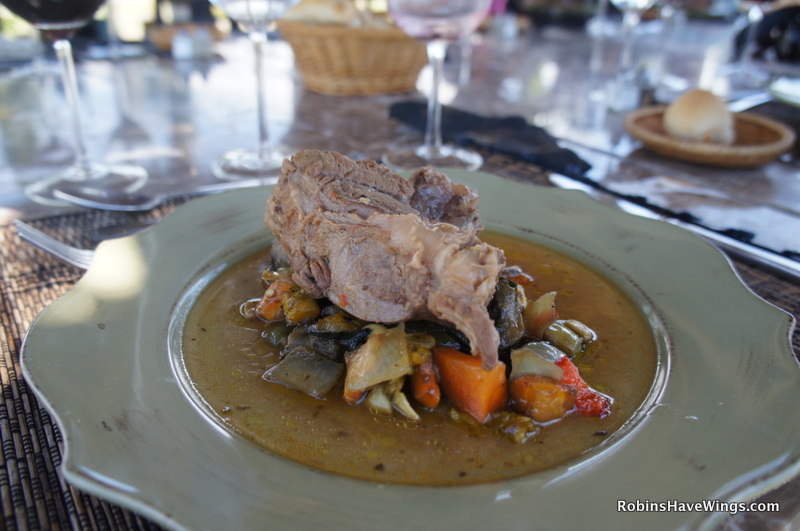
We’ve eaten and enjoyed the wines from the Altus vineyard until our stomachs say uncle. To say that we are content is an understatement. It’s been a perfect day minus the flies that were determined to dine with us. We try to express how much we’ve enjoyed the experience with words like “phenomenal” and “incredible,” again and again. Presleith says this is the best meal she’s had on the trip so far and that it reminds her of grandmother’s cooking in the Bahamas. Robyn toasts Gai for organizing such a fabulous day. But again, it’s one of those experiences that you have to have for yourself. It turns out that cooking together forms a bond, too. Not just amongst our group but with Lucas, Michaela and the wonderful people we met at La Tupiña Bistro. We won’t soon forget them or the meal that we shared.

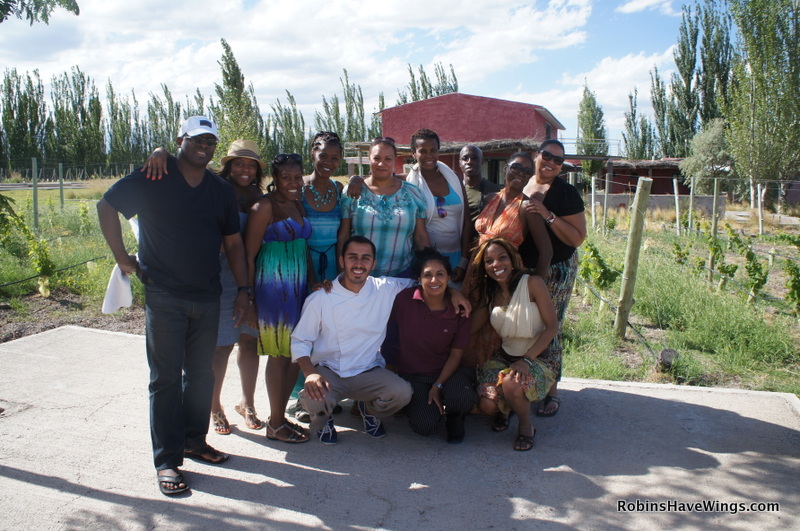
I love your description of this enticing wine tour. What a treat! I love Malbec it is one of my favorite wines.
A Bonne Sante!
This is my favorite posting of our trip. Love them all but this is the best description of our day at the vineyards.
Thanks, Gia. This is one of my favorites, too. I’m especially proud that I got that shot of the Gauchito Gil memorial.